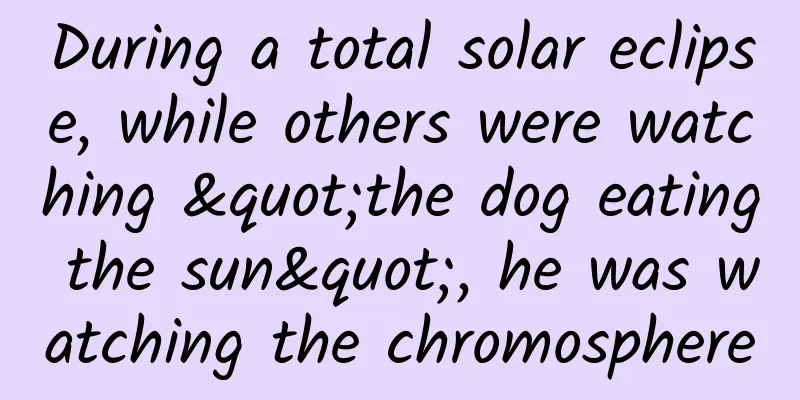During a total solar eclipse, while others were watching "the dog eating the sun", he was watching the chromosphere

|
Editor’s Note: If you had the opportunity to watch a solar eclipse, what would you focus on? The author of this article is engaged in solar-related research. In early April, he also saw the total solar eclipse for the first time in the United States. As an "insider", what does he think the solar eclipse is like? On the afternoon of April 8, 2024, North American time, the only total solar eclipse in the world this year took place on the North American continent. This total solar eclipse can be observed simultaneously in Mexico, the United States and Canada. There are 32 million permanent residents in the total solar eclipse zone. Many residents in North America can see this celestial feast as long as they step out of their homes. They are quite lucky. The next time the continental United States can directly observe a total solar eclipse will be in 2044, so for some older people in North America, this may really be their last chance to see a total solar eclipse. This year coincides with the peak year of the solar cycle (Solar Cycle 25), and this is the only total solar eclipse in the solar peak year (2024-2025), so this total solar eclipse is particularly precious. The academic community also attached great importance to this total solar eclipse. For example, the TESS conference (Triennial Earth-Sun Summit) was held in Dallas, which is in the eclipse zone. In San Antonio, there was also a total solar eclipse academic conference (it is indeed called this name...) jointly held by three of the world's most advanced solar observation instruments (NASA's Parker Solar Probe PSP, ESA's Solar Orbiter, and the Inouye Solar Telescope DKIST in Hawaii. By the way, the first two were built specifically for this solar year). I attended this total solar eclipse academic conference and watched the solar eclipse with many colleagues. For most of us, it was the first time to see a total solar eclipse. From the time-lapse photography, we can clearly see the process of the sky changing from bright to dark (and then bright again): Part 1 The sun was not "eaten", it was just blocked If the moon moves between the sun and the earth and the three are in the same straight line, the moon will block the light from the sun to the earth, thus forming a dark shadow on the earth's surface. This is a solar eclipse. The shadow cast by the moon on the earth's surface can be divided into two regions: the umbra and the penumbra. People in the umbra can enjoy the most spectacular astronomical phenomenon that can be seen with the naked eye - a total solar eclipse. Correspondingly, people in the penumbra can enjoy a partial solar eclipse or an annular solar eclipse through eclipse glasses. Schematic diagram of the umbra and penumbra (Image source: https://www.businessinsider.com/solar-eclipse-diagram-2017-8) The picture below shows the shadow of the moon on the earth taken by the Starlink satellite during the total solar eclipse. The dark black part is the umbra area. (Image source: https://twitter.com/Starlink/status/1777441354588791206) Part 2 Come with us and see the sun that you can't see normally. A solar eclipse is a great time to observe the structure of the Sun. The sun's atmospheric structure is divided into four layers, but the only layer we can see is the photosphere (photo is the Latin root for light). The rest can only be seen during a solar eclipse. Solar atmosphere structure When a total solar eclipse occurs, the moon will completely cover the photosphere. The temperature of this part is about 6000 degrees Celsius. According to the blackbody radiation formula, we can know that its main electromagnetic radiation energy is concentrated in the visible light band (380 nanometers to 750 nanometers). When the photosphere is completely blocked, the upper atmosphere of the sun, which is usually obscured by the sun's white light, will shine, namely the chromosphere (Chromosphere, Chromo is the Latin root meaning color) and the corona (Corona, named because of its shape similar to a crown). 1. Chromosphere After the eclipse is at its greatest, the most eye-catching feature of the total solar eclipse is the bright red structures dotted outside the moon. This is the chromosphere, and the particularly prominent part of it is called the prominence. The chromosphere is an unstable (and therefore bumpy) layer of the solar atmosphere, and the reason for its formation is still a partially unsolved mystery. The chromosphere is bright red because its temperature is about 10,000 to 35,000 degrees Celsius. Under the action of high temperature, the electrons of hydrogen atoms on the surface of the chromosphere are excited, and the energy level transition from n=3 to n=2 occurs. Among the electromagnetic waves released by these electron energy level transitions, the H-alpha line of the Balmer line series with a wavelength of 656.46 nanometers is absolutely dominant in brightness, so the color of the chromosphere appears bright red. In fact, the chromosphere is quite thin, generally only 2,000 kilometers thick, less than 3% of the radius of the sun. Therefore, we can only see the true appearance of the chromosphere when the relative motion of the moon and the earth reaches a certain special position, that is, when a total solar eclipse occurs . 2. Corona Outside the chromosphere, we can also see a faint white structure, which is named the corona because it resembles a crown. Although it cannot be observed with the naked eye, if we use multiple low-exposure photos to synthesize them during a total solar eclipse, we can use the camera to capture the corona extending up to 20 solar radii. In the picture above, we can see that at this time, the solar year is high, and coronal loops, helmet streamers, pesudo-streamers and coronal plumes are spread all over the surface of the sun. The 2019 South American total solar eclipse on the left and the 2023 Australian total solar eclipse on the right (Photographers: 2019 Miloslav Druckmüller, Peter Aniol; 2023 Pavel Štarha, Shadia Habbal, Miloslav Druckmüller) The two corona images above show the highest level of solar eclipse photography in human history. The solar activity cycle is determined by the number of sunspots on the surface of the sun. 2019 is the first year of the 25th solar activity cycle and the weakest year. It can be seen that the corona shows a textbook standard structure - there are large-scale helmet-shaped flows on the ecliptic plane, and the north and south poles are open magnetic lines corresponding to the plumes. 2023 has entered a high year of solar activity. It can be seen that the plumes extend in all directions, and we can even see a coronal mass ejection (CME) in the lower left corner of the picture. Total Solar Eclipse and Coronagraph Comparison (Photographer: 2015 Miloslav Druckmüller, Shadia Habbal, Peter Aniol, Pavel Štarha & ESA, NASA) You may be curious, with the advanced technology, can't scientists see the corona at any time? The answer is: yes and no. The above picture is a comparison of the corona during the 2015 Faroe Islands solar eclipse. The left side is a total eclipse photo, and the right side is an image of the LASCO coronagraph on NASA's SOHO spacecraft. It can be seen that the sun blocked by the moon allows us to see far more details than the coronagraph. In addition, the coronagraph can only see the corona outside two solar radii. The total solar eclipse is still our only means of observing the corona within two solar radii . Part 3 Ding! Please check the total solar eclipse (incomplete) observation notice If you miss this solar eclipse, don't feel too bad. The next total solar eclipse will be on August 12, 2026. If you want to observe this eclipse, you can go to the sea near the west coast of Greenland, Iceland, or parts of Spain and Portugal. It is worth noting that in Spain and Portugal, this solar eclipse will occur at sunset - imagine Spain in midsummer, at sunset on the Atlantic coast, the moon and the sun abide by the agreement made millions of years ago and eclipse each other here, it would be quite romantic (laughs). If you want to see a total solar eclipse in China, there will be one in 2034 and one in 2035. The 2034 total solar eclipse will be staged at sunset in the western part of the Qinghai-Tibet Plateau, while the 2035 total solar eclipse can be seen near Beijing. I wonder what you will see during the next solar eclipse after reading this article? Source: Science Academy Official Account |
Recommend
The Lord of the Rings/The Lord of the Rings 1-3 Collection (Blu-ray Ultra HD Extended Edition) Chinese and English Multi-track
"The Lord Of The Rings", also known as ...
These 3 information flow cases increased my monthly salary to 30,000!
Next, let’s look at some interesting cases. Case ...
When a person is crying, he starts to "twitch", not because of fear but because of "poisoning"
When we were young, we might be beaten by our par...
What do bidding promoters need to do every day? How to do bidding promotion?
For many friends who have just entered the biddin...
Mobile phones are getting more powerful, but they still have flaws, and these three are the most serious
Although mobile phones have been developed for so...
Going to work slowly, rushing off work quickly! How does the new top star walk with his head and body showing off separately!
Beijing Winter Paralympics is about to open Xue R...
Technology Morning News | Shanghai adds 3 medium-risk areas
【Today’s cover】 Golden rays of light pierce throu...
Travel App Competitive Analysis: How long will the social journey of travel apps last?
The outline of this article is as follows: 1. Pur...
One article tells the past and present of the "short video trend"
On April 22, Papi Jiang, who became famous throug...
Methods to obtain website external links for free, website platforms that can post external links for free
"Content is king, external links are emperor...
What are the benefits of developing mini programs in Guangzhou? Who to find for development?
2018 is the second year of the birth of Mini Prog...
Do you want to know the 6 key principles of brand operation?
What? Is there such a magical job as brand operat...
How shared bikes make profit from "impossible" to "possible"
In two articles I wrote recently, I talked about ...









